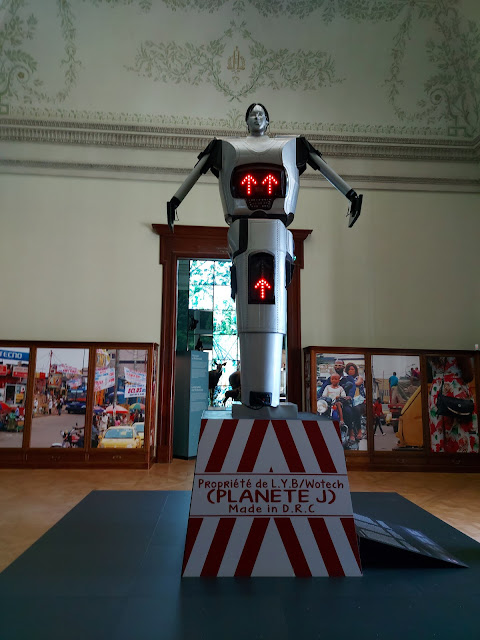 |
| Brussels is the capital of Belgium. Much of Belgium's wealth as an independent country was derived from exploiting the Congo. |
 |
| The wall of things that are still racist |
 |
| The first exhibit in the museum shows the old statues featured in the museum. |
 |
| There was a struggle over what the museum should be. In 2013. |
 |
| Mukanda masks |
 |
| A variety of masks from Africa |
 |
| A traffic direction robot from the DRC. |
 |
| The museum has covered up statues of white Belgians helping the Congolese rise out of their perceived savage state. |
 |
| The Bali people in north-east Congo did actually assassinate people using claws dressed as leopards. |
 |
| The royal mask of the Kuba people |
 |
| A nkisi contains a spirit of an ancestor. You can drive nails into the statue to activate it to help you. |
 |
| These ones got a lot of use. They were supposed to ward off sleeping sickness. |
 |
| Besides being home to some of the greatest crimes against humanity, Belgium also has some great beer. |
 |
| And some odd restaurant mascots. |
 |
| No trip to Brussels is complete without a trip to Maison Dandoy for a waffle with Speculoos and a coffee. |
 |
| Brussels is the capital of the EU and hosts the Parlamentarium, a museum about the EU. It was actually pretty interesting, if a bit saccharine. |
 |
| Right now all of Europe can agree on one thing: Russia bad, Ukraine good. |
 |
| I'm not sure why these ostriches had their heads in the sand next to the EU complex. |
 |
| The Parc du Cinquantenaire houses many museums, including the Musee Art & Histoire. |
 |
| It has a great collection of artifacts from around the world. Also some looted, I'm sure. |
 |
| They had a great exhibit about aboriginal art from Australia. Some tribes would dry and crush their dead, then place them in these hollow burial poles. |
 |
| Sacred hearts |
 |
| Looks like Belgium had some German influence. |
 |
| Not your average Christ rising from the dead |
 |
| Spooky tombstones from the 1200s |
 |
| A ghost you definitely don't want to encounter in a church at night |
 |
| Who knew tapestries could be so much fun? |
 |
| Brooches found in Belgium during the 500s-700s. |
 |
| They also had very fashionable beads back then. |
 |
| The reliquary of Pope Alexander from 1145 |
 |
| With sleds, your imagination is the limit. |
 |
| Art Nouveau... does it belong in a museum? |
 |
| The museum was enormous. We were pretty exhausted by the time we reached the other half. |
 |
| Cuneiform tables with friezes |
 |
| I think this is a Mamluk Sultan's helmet from the 1300s. I can't read Dutch or French... |
 |
| This tile panel shows a man fleeing from lions. It was made in Isfahan for the Safavid shah in the 17th century. |
 |
| A vase made during the reign of Napoleon, showing the trials of Hercules in kind-of classical style |
 |
| The Belgian Triumphal Arch, constructed in 1905 |
 |
| The Cathedral of St. Michael and St. Gulda is Brussels most prominent religious building. |
 |
| Saint Gudula lived in an abbey in Brabant in the 600s, and was known for her good works. |
 |
| The main structure of the church took 300 years to complete, from 1226 to 1519. Charles V was crowned King of Spain here soon after. |
 |
| The most impressive spot in Brussels is the Grand Palace, encircled with building glowing with gold inlay, built in the 14th century. |
 |
| Brussels was extremely wealthy from being on the trade routes between Bruges, Ghent, and Cologne, and later as the capital of the Burgundian Netherlands. |
 |
| You have to eat mussels in Brussels, so we dined at Chez Leon. The restaurant is self-aware that its kind of a tourist trap. |
 |
| At least their having a good time. |
 |
| They were also famous for this appetizer, with tiny shrimps and a tomato filled with something like mayonnaise. I'm not quite sure what to make of it. |
 |
| The mussels, as you would expect, were excellent. |

No comments:
Post a Comment